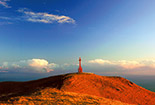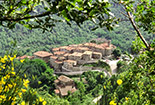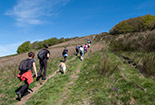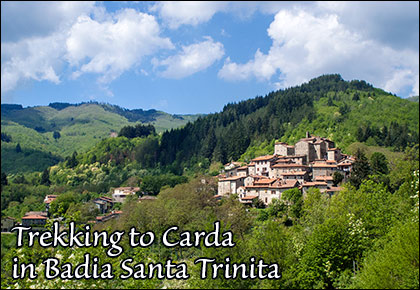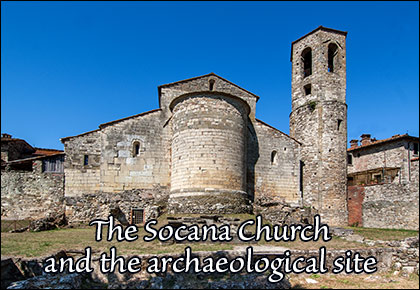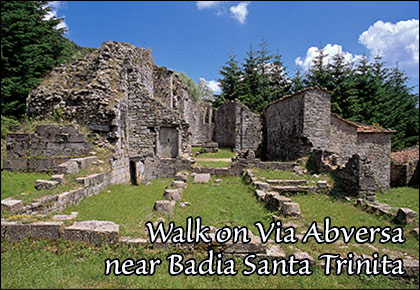Carda
in Casentino, a Tuscan valley with which you can get familiar in every detail through this site
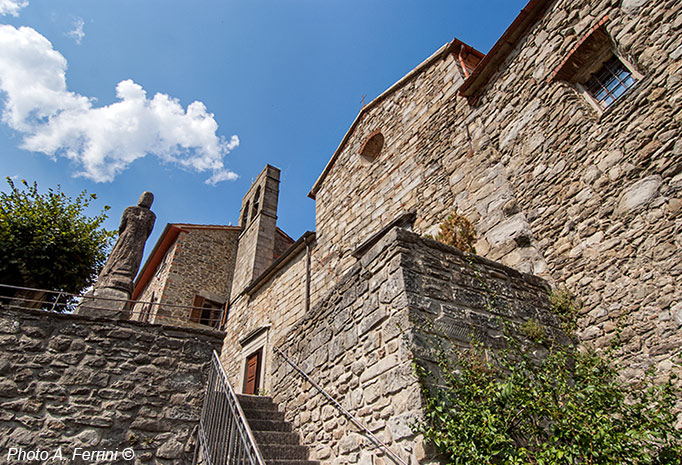
Texts and photos by Alessandro Ferrini ©
40 immagini in sequenza di Carda accuratamente descritte. Clicca per ingrandire
Carda, a mountain village with an important but little-known history
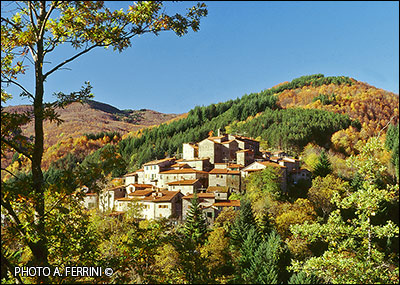 Carda is a mountain hamlet of the Municipality of Castel Focognano located on the southern slopes of Pratomagno, at 710 meters above sea level. To reach this village in Rassina we go towards Talla following the Provincial Road 59. After five hundred meters, at the height of Pieve a Socana, we must turn right. From here there are twelve kilometers of a somewhat narrow, but asphalted road. After four kilometers we find Castel Focognano, a place documented as early as 1022 and probably the first castle built by the feudal bishops of Arezzo to control their territories in Casentino. Castel Focognano, which gives its name to the municipality we are visiting (the municipal seat is located in Rassina) is undoubtedly worth a short visit.
Just before Carda we find a fork where we have to go left. Going right, instead, we will reach the village of Calleta (a toponym probably linked to transhumance). From here a forest road continues that takes us up almost to the crest of Pratomagno, Cima Bottigliana area, 1454 meters.
Seen from afar, Carda will seem to be perched on the slopes of the mountain, but when we are there we will notice that it is located on a sort of small hill. An ideal place for a castle and in fact it is thought that the origin of Carda was this, but no traces of fortifications have ever been found. On the top of the hill is the church dedicated to Saints Flora and Lucilla. This dedication is important because it recalls that from the 11th to the 13th century the place was a possession of the Badia di Arezzo whose church was, and is, dedicated to these two martyred sisters in about 260. In the second half of the 13th century, Carda was owned by the noble and powerful Ubertini family from Arezzo to which Guglielmino, the well-known bishop and leader, belonged. For the Bishopric of Arezzo, the place was an outpost towards the territory of the Guidi Counts which was located just beyond the hill, the current Teggina valley. When in the sixth decade of the fourteenth century the Florentine Republic acquired dominion over this
Carda is a mountain hamlet of the Municipality of Castel Focognano located on the southern slopes of Pratomagno, at 710 meters above sea level. To reach this village in Rassina we go towards Talla following the Provincial Road 59. After five hundred meters, at the height of Pieve a Socana, we must turn right. From here there are twelve kilometers of a somewhat narrow, but asphalted road. After four kilometers we find Castel Focognano, a place documented as early as 1022 and probably the first castle built by the feudal bishops of Arezzo to control their territories in Casentino. Castel Focognano, which gives its name to the municipality we are visiting (the municipal seat is located in Rassina) is undoubtedly worth a short visit.
Just before Carda we find a fork where we have to go left. Going right, instead, we will reach the village of Calleta (a toponym probably linked to transhumance). From here a forest road continues that takes us up almost to the crest of Pratomagno, Cima Bottigliana area, 1454 meters.
Seen from afar, Carda will seem to be perched on the slopes of the mountain, but when we are there we will notice that it is located on a sort of small hill. An ideal place for a castle and in fact it is thought that the origin of Carda was this, but no traces of fortifications have ever been found. On the top of the hill is the church dedicated to Saints Flora and Lucilla. This dedication is important because it recalls that from the 11th to the 13th century the place was a possession of the Badia di Arezzo whose church was, and is, dedicated to these two martyred sisters in about 260. In the second half of the 13th century, Carda was owned by the noble and powerful Ubertini family from Arezzo to which Guglielmino, the well-known bishop and leader, belonged. For the Bishopric of Arezzo, the place was an outpost towards the territory of the Guidi Counts which was located just beyond the hill, the current Teggina valley. When in the sixth decade of the fourteenth century the Florentine Republic acquired dominion over this  valley (which would become Valle Fiorentina) and over the Castle of Raggiolo, for the people of Arezzo it made little sense to remain in this place and wait to be chased away by the Florentines, so they left Carda but not before donating it to the monks of the nearby Badia di Santa Trinita. A bond began between the abbey and Carda that would continue even when the latter was included in the Florentine dominions (around 1380) and would be strengthened after 1425 when Santa Trinita came under the jurisdiction of the monks of Vallombrosa, who had already been linked to Florence for a long time.
Dating the origins of Carda is not easy, documentation is scarce or non-existent. Certainly the proximity to two towns like Raggiolo and Quota where the Lombards had their settlements, can lead one to think the same thing for Carda. Strengthening this hypothesis is the discovery in the town of a stone (part of a ciborium), now exhibited in the church, on which are sculpted, in Lombard style, two peacocks drinking under a cross (symbol of immortality). This stone with the interesting chiselling can be dated to the 9th/10th century (we are talking about Lombard style, not the Lombard era). It is unlikely that the stone was brought here from elsewhere, it is more logical to assume that it belonged to a church already present in that period. But a Lombard style present in the local culture necessarily leads one to think of a previous settlement of this barbaric people who were always very inclined to build control centers of the territory and relative towers on every point they considered strategic.
Relative to its size and the small village where it is located, the Church of Carda can be defined as a place of art. Together with seventeenth-century works of lesser artistic value commissioned by the parish priests of the time, the church houses a fifteenth-century panel and a Madonna in the Robbian style of
valley (which would become Valle Fiorentina) and over the Castle of Raggiolo, for the people of Arezzo it made little sense to remain in this place and wait to be chased away by the Florentines, so they left Carda but not before donating it to the monks of the nearby Badia di Santa Trinita. A bond began between the abbey and Carda that would continue even when the latter was included in the Florentine dominions (around 1380) and would be strengthened after 1425 when Santa Trinita came under the jurisdiction of the monks of Vallombrosa, who had already been linked to Florence for a long time.
Dating the origins of Carda is not easy, documentation is scarce or non-existent. Certainly the proximity to two towns like Raggiolo and Quota where the Lombards had their settlements, can lead one to think the same thing for Carda. Strengthening this hypothesis is the discovery in the town of a stone (part of a ciborium), now exhibited in the church, on which are sculpted, in Lombard style, two peacocks drinking under a cross (symbol of immortality). This stone with the interesting chiselling can be dated to the 9th/10th century (we are talking about Lombard style, not the Lombard era). It is unlikely that the stone was brought here from elsewhere, it is more logical to assume that it belonged to a church already present in that period. But a Lombard style present in the local culture necessarily leads one to think of a previous settlement of this barbaric people who were always very inclined to build control centers of the territory and relative towers on every point they considered strategic.
Relative to its size and the small village where it is located, the Church of Carda can be defined as a place of art. Together with seventeenth-century works of lesser artistic value commissioned by the parish priests of the time, the church houses a fifteenth-century panel and a Madonna in the Robbian style of 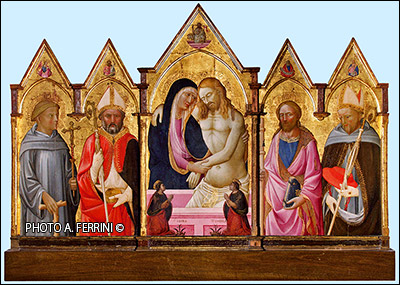 absolute value. Two works that did not belong to Carda and that the small village found itself, we can say by chance, in the space of a short time, sixteen years. The first to arrive (August 1554) was the Virgin with Child in glazed terracotta today attributed to Santi Buglioni (around 1520). Four men from Carda brought it from the Valdichiana where they had fought alongside the Florentine troops in the famous battle of Scannagallo against Siena. In 1570, instead, the polyptych by Mariotto di Cristofano (1425/26) arrived from Badia Santa Trinita. Both of these works are described and their history is told on pages 20 and 23 of the sequence.
Since time immemorial and until a few decades ago the population of this town has drawn sustenance from cutting down the woods, from chestnuts, from sheep farming, from poor agriculture. Today there are about a hundred people living here permanently, few but at the same time many compared to other villages on the slopes of Pratomagno. In the summer Carda is crowded, not so much with tourists, but with people returning to their parents' or grandparents' house. People who love the place, for this reason the town appears very tidy. The alleys are well paved and the houses are carefully renovated, which is why it is a real pleasure to walk inside the small town. Just as it is pleasant to go to the Bonano stream via a short walk. For trekking lovers, two routes (CAI 36 and 38) start from Carda and lead to the surrounding mountains.
absolute value. Two works that did not belong to Carda and that the small village found itself, we can say by chance, in the space of a short time, sixteen years. The first to arrive (August 1554) was the Virgin with Child in glazed terracotta today attributed to Santi Buglioni (around 1520). Four men from Carda brought it from the Valdichiana where they had fought alongside the Florentine troops in the famous battle of Scannagallo against Siena. In 1570, instead, the polyptych by Mariotto di Cristofano (1425/26) arrived from Badia Santa Trinita. Both of these works are described and their history is told on pages 20 and 23 of the sequence.
Since time immemorial and until a few decades ago the population of this town has drawn sustenance from cutting down the woods, from chestnuts, from sheep farming, from poor agriculture. Today there are about a hundred people living here permanently, few but at the same time many compared to other villages on the slopes of Pratomagno. In the summer Carda is crowded, not so much with tourists, but with people returning to their parents' or grandparents' house. People who love the place, for this reason the town appears very tidy. The alleys are well paved and the houses are carefully renovated, which is why it is a real pleasure to walk inside the small town. Just as it is pleasant to go to the Bonano stream via a short walk. For trekking lovers, two routes (CAI 36 and 38) start from Carda and lead to the surrounding mountains.



